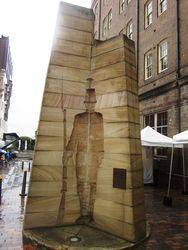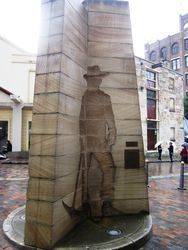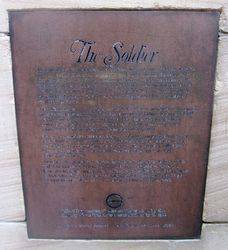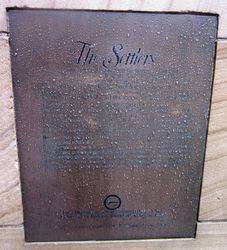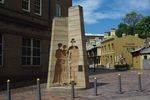
Home » Themes » Landscape » Settlement
"First Impressions"Print Page 
The sandstone relief sculpture symbolises the origins and settlement of the colony of New South Wales.
"First Impressions" was commissioned by the Sydney Cove Redevelopment Authority in 1979.
Location
| Address: | Playfair Street, The Rocks, 2000 |
|---|---|
| State: | NSW |
| Area: | AUS |
| GPS Coordinates: | Lat: -33.857888 Long: 151.208633 Note: GPS Coordinates are approximate. |
Details
| Monument Type: | Sculpture |
|---|---|
| Monument Theme: | Landscape |
| Sub-Theme: | Settlement |
| Designer: | Bud Dumas |
Dedication
| Approx. Monument Dedication Date: | 1979 |
|---|
The Settlers
Governor Phillip (1788 - 1792) was given the power to grant land in small parcels to ex convicts. His instructions also suggested that "every reasonable encouragement" be given to soldiers and other free persons wanting to settle. In 1789 James Ruse was given a free pardon, supplied with seed, livestock, farm implements, convict labour and a few acres at Rose Hill and thus became Australia's first settler.
Australia's first eleven free immigrants landed in Sydney in 1793 in response to repeated requests for experienced farmers, mechanics and convict supervisors. 63,000 convicts and 14,000 free immigrants arrived in Australia between 1788 and 1830. Land grants were abolished in 1831. Thereafter Crown land was sold at fixed prices with the income going to England to subsidise schemes of free or inexpensive immigration.
Between 1830 and 1850, 83,000 convicts and 173,000 free settlers arrived bringing Australia's population to 400,000. At this time there were only 7 women for each 10 men with most people living outside the towns and engaged in some form of primary production. The 1850 - 60 Gold Rush periods swelled the population to 1,145,000, established a decentralised pattern of inland towns and signalled the beginning of the immigration of the diverse range of nationalities that make up today's Australia.
"First Impressions" was commissioned by the Sydney Cove Redevelopment Authority in 1979.
This plaque was presented by the Fellowship of First Fleeters



